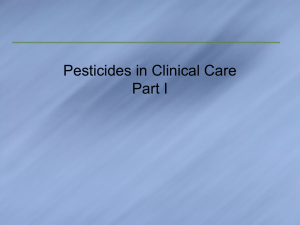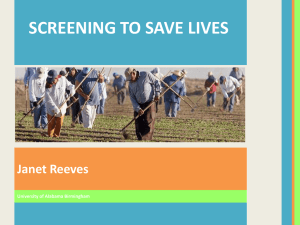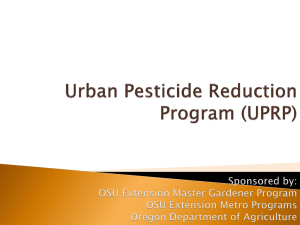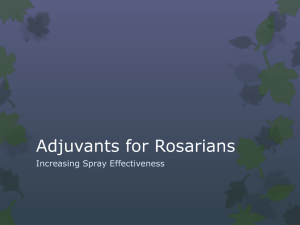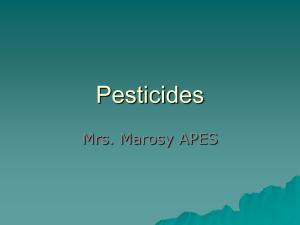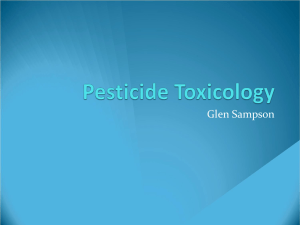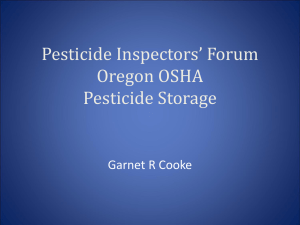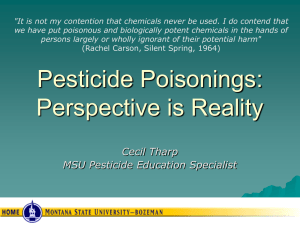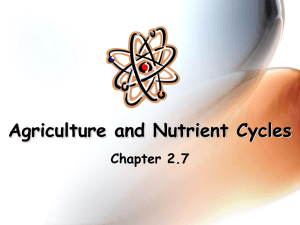PowerPoint Presentation - Intro
advertisement
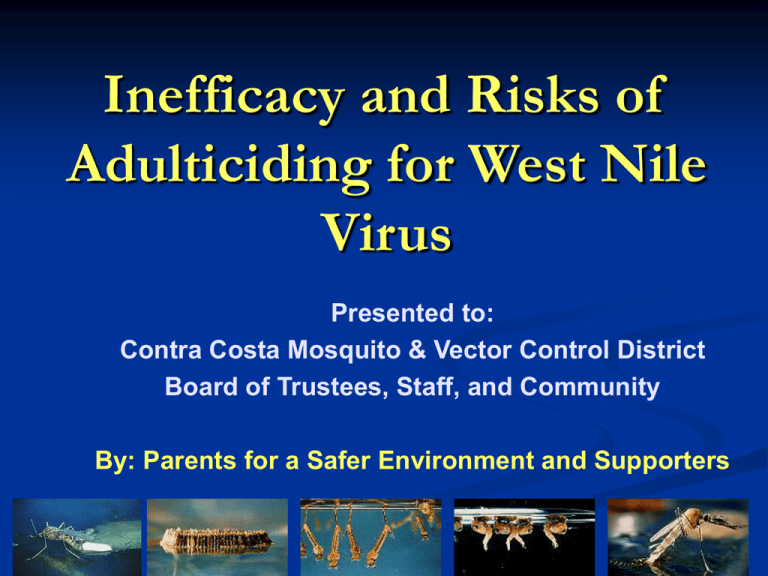
Inefficacy and Risks of Adulticiding for West Nile Virus Presented to: Contra Costa Mosquito & Vector Control District Board of Trustees, Staff, and Community By: Parents for a Safer Environment and Supporters 1 PfSE is a grass-roots, volunteer group Director: Susan JunFish, MPH, BS Steering Committee: Susan JunFish, Cynthia Mantel, Roxanna Hariri, Carol Shenon, Rita Smith, Jane Zhai Advisory Board: Sophia Chernikova, PhD, Stanford Oncology (cancer) Researcher Naresh Duggal, MS, Santa Clara County IPM Manager Jeremy Fish, MD, Physician & U.C. Davis Professor of Medicine Susan Kegley, PhD, Chemist & Senior Scientist, PANNA Ken Maderra, MS, & Larry Chen, MS, Computer Analysts Myrto Petreas, PhD, MPH, Cal/EPA Scientist & Researcher Debbie Raphael, MS, Toxics Reduction Manager, S.F. County Margaret Reeves, PhD, Ecologist & Senior Scientist, PANNA Chris Geiger, PhD, Entomologist, S.F. Dept of Environment Cynthia Russell, MD, Oncology Surgeon Stephen Scholl-Buckwold, PhD, Director of PANNA Joan Reiss, RN, Consultant for Breast Cancer Fund Mission Statement Protect the Healthy Development of the Most Vulnerable Population, including the Fetus and Children, from Preventable Environmental Hazards 3 Presentation will Address : Inefficacy of Adulticides Human Health Risks from Adulticiding Ecosystem Risks from Adulticiding 4 Harvard Study on Efficacy, 2006 Do Mosquito #’s Decrease after Adulticiding as Compared to Controls? 3 Different Suburban Neighborhoods in MA. Truck-based Ultra Low Volume (ULV) Spraying Adulticiding Pesticide Used: Resmethrin Sprayed at peak flight time, 2 hours after sunset. 5 Harvard Study on Efficacy, 2006 Tested on Free Mosquitoes, Not Caged Studied Reproductive Activity Difference instead of infection rates. Females that had a Blood Meal, and may Carry West Nile virus will Attach to the “Ovitrap” to Lay Eggs. Counted (eggs in clumps) in Ovitraps Laid before & after Spray. Counted at Least 2 Days Prior to and Up to 2 Weeks After Spraying. 6 Harvard Efficacy Study Conclusion About as many eggs were deposited by each species of mosquito before adulticiding as afterwards, similar to the non-treated neighborhoods. “…ULV applications of resmethrin had little or no impact on Culex vectors or WNV, even at maximum permitted rates of application...we conclude that insecticidal aerosoles dispersed from the road may not effectively reduce the force of transmission of WNV.” 7 What’s In a Pesticide? Active Ingredients Kill or repel living things. Inert Ingredients Make up >95% of most pesticides US EPA: “all inert ingredients are not non-toxic” Contaminants & Breakdown Products These can be more toxic Only Active Ingredients are required to be labeled although the other ingredients can be more toxic. 8 Health Effects of Pesticides Acute asthma nausea headaches rashes dizziness aching joints flu-like symptoms mental disorientation/ inability to concentrate respiratory problems Chronic asthma cancer birth defects & reproductive harm developmental disabilities endocrine disruption neurological toxicity development of chemical sensitivities 9 Pesticides: A Major Environmental Risk - Asthma Reproductive Outcomes Cancer Dermatitis Learning Impairments Alzheimer’s Parkinson’s Chronic Fatigue Syndrome CA State Dept of Health Services, Office of Environmental Health Hazard Assessment, Data Tracking Program, 2005. 10 Most Vulnerable Population Fetus Infants & Children Adolescents The Elderly & those with compromised immune and nervous systems Those with allergies, liver dysfunction, sensitivity to chemicals 11 Children More Vulnerable to Toxics Physiological : Eat, drink & breathe more than adults relative to body weight (higher intake) Immature system less able to detoxify and excrete chemicals as adults can Developing organ systems more susceptible Behavioral : Play on floors and ground where pesticides concentrate; get into low accessible areas Place hands and things in their mouths 12 Cumulative Effect of Pesticides Exposure to very low levels of combined pesticides result in higher toxic effects vs. single exposures. Toxicity can cumulate across time. Lab animals are more vulnerable to pesticide exposures later in life when exposed to hormone disruptors during developmental period. Developmental exposures can cumulate with other risk factors, such as other toxicants, advancing age and genetic background; these can also cumulate with exposures. ~ Deborah A. Cory-Slechta, Ph.D. Director, Environmental and Occupational Health Sciences Institute University of Medicine, New Jersey and Rutgers University 13 An Adulticide Used: Pyrethroid Family CCMVCD uses “Scourge”, w/ Resmethrin. There are ~ 20 Pyrethroids and not all have been studied for Reproductive/Developmental Toxicity, Hormone Disruption, and Cancer. Pyrethroids act similarly as organophosphates, targeting the Nervous system. Acute Exposure: Asthma and Respiratory Effects Chronic Exposure: Reproductive & Developmental Damage, Cancer, and Hormone Disruption. 14 Pyrethroids Toxicity CCMVCD applies resmethrin at 1.52 grams/acre, an amount that appears small. Concentration of resmethrin just prior to spraying is in the uM concentration range. Breast cancer study of pyrethroids impact showed uM concentrations triggering cancer in cells. Wind or failure of the Spraying System can result in unpredictable deposition of adulticides in higher concentrations than from functioning system. 15 Pesticide Residues Found in Every Person Tested • Average was 13 Pesticides/Person • 50% had 18 different Pesticides • Children had Highest Level Pesticides, sometimes 200% Higher ~ Center for Disease Control, 2003 • 43 of 148 chemicals studied were pesticides. • Pyrethroids were found in most people tested, and were the most common insecticides ~ Center for Disease Control, 2005 detected. 16 Pattern: Approve Now, Ban 30 yrs Later DDT comes on market in 1940’s Diazinon & Dursban replace DDT in 1970’s banned in 1972 after 30 yrs of contamination. banned in 2005 for residential application. Pyrethroid use steps up to replace Diazinon & Dursban in 2000’s. Most common insecticide found in spray cans, flea control for homes and used by pest control operators. CA Dept Pesticide Regulation Re-evaluating due to risks to the environment and thus to people. 17 Adulticides & Aquatic Toxicity Pyrethroids are very toxic to water organisms that are used as health indicators in sediment. Piperonyl butoxide mixed with the wrong, existing pesticides in creeks and increased toxicity by 200%. “…interaction of compounds is a whole new issue when doing pesticide risk assessments that has been largely ignored by regulators…” Donald Weston, PhD U.C. Berkeley, Dept of Integrative Biology, Env. Toxicology 18 Results from U.C. Aquatic Toxicity Study CA Dept of Pesticide Regulation has begun reevaluating 600 pyrethroid-containing products, including adulticides used for mosquito control. Regulators will have to consider toxicity of a product from interactions of chemicals already existing in the environment. Interactions of PBO and pesticide residues already existing in human bodies is now being questioned for more research. 19 American Medical Association “Particular uncertainty exists regarding the long-term health effects of low dose pesticide exposure… Considering [the] data gaps, it is prudent … to limit pesticide exposures … and to use the least toxic chemical pesticide or non chemical alternative.” ~ American Medical Association, Council on Scientific Affairs, 1997 20 Pesticide Safety: U.S. General Accounting Office "The general public receives limited and misleading information on pesticide hazards and is misled on pesticide safety by statements characterizing pesticides as safe or harmless." ~ U.S. General Accounting Office, 1997. 21 Summary of Adulticide Toxicity Known to be of higher risk to public health and environment as compared to larvicides. Pesticides even at “low doses” are linked to illnesses such as asthma, hormone disruption, developmental/reproductive damage, & cancer. The Fetus, Children, the Elderly, and the immune-suppressed are the most susceptible. Leading Researchers, Government, and Professional groups give warnings on Current Exposures and Discourage Adulticiding. 22 Prudent Steps for CCMVCD Board Suspend All Adulticiding until Efficacy of Decreasing WNV is Shown and that the Risk from Contracting WNV is Shown to be Higher than the Risk from Exposure to the Adulticides. Increase Work on Larvicing and Public Outreach to Provide Improved Controls of Breeding Sites. Provide a Special Public Workshop that includes Community, CCMVCD Staff and Board members to Discuss and Address Adulticiding and Safer Alternatives. 23 Pesticide Info Resources UCSF Pediatric Environmental Health Specialty Unit (PEHSU): 1-866-827-3478. www.ucsf.edu/ucpehsu. Advice to public on pesticide toxicity. • Comprehensive toxicity info if you have the exact name or US EPA registration # of pesticide: www.panna.org. Click on “PAN Pesticide Database” on left-hand column. • US EPA funded Pesticide Hotline: 1-800-858-7378 www.npic.orst.edu/index • Biointegral Resource Center: www.birc.org. Dr. Bill Quarles have reviewed efficacy of adulticiding from studies around the world, concluding it ineffective. 24
